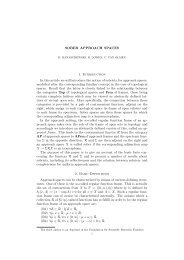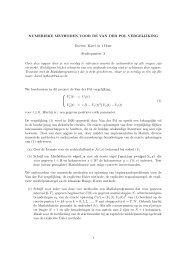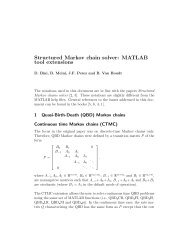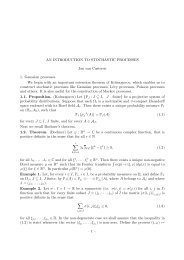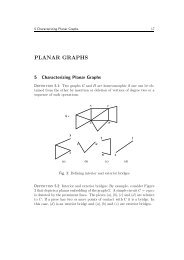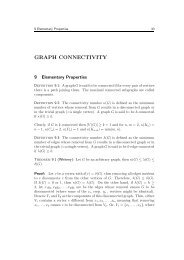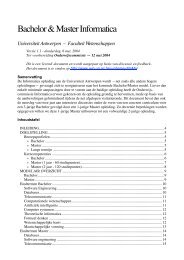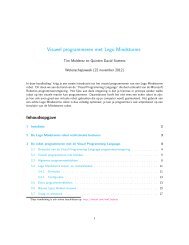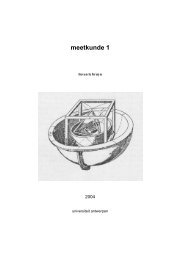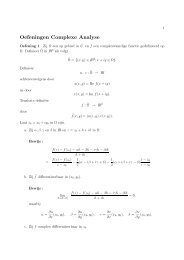Table 1: Overview statistics.General statistics Krimp <strong>Slim</strong>Dataset |D| |I| %1s |cl| minsup L% |CT | |F| L% |CT | |F|Abstracts 859 3933 1.2 - 3 91.9 1102 6 M 84.3 1815 13 MAccidents 340183 468 7.2 - 50000 55.1 1583 3 M 31.1 2018 21 kAdult 48842 97 15.3 2 1 24.4 1303 58 M 22.8 1201 199 kBMS-pos 515597 1657 0.4 - 100 81.7 9478 6 M 83.1 1964 15 kBMS-webview 1 59602 497 0.5 - 35 85.9 718 1 M 84.0 965 2 MChess (k-k) 3196 75 49.3 2 500 30.0 275 846 M 14.7 292 20 kChess (kr-k) 28056 58 12.1 18 1 61.6 1684 373 k 57.5 1060 28 kConnect-4 67557 129 33.3 3 40000 42.9 56 24 M 12.3 1670 297 kDNA amplification 4590 391 1.5 - 9 36.7 326 312 M 35.7 359 67 kIonosphere 351 157 22.3 2 35 59.8 170 226 M 49.7 240 294 kLetter recognition 20000 102 16.7 26 1 35.7 1780 581 M 33.4 1599 521 kMammals 2183 121 20.5 - 200 48.1 316 94 M 39.9 434 235 kMCADD 31924 198 11.1 2 35 55.4 2280 2 M 51.0 4067 924 kMushroom 8124 119 19.3 2 1 20.5 442 6 G 18.5 340 16 kPen digits 10992 86 19.8 10 1 42.2 1247 459 M 39.4 1347 394 kPlants 34781 70 12.4 - 2000 46.4 511 913 k 36.1 840 179 kPumsb 49046 2113 3.5 - 35000 70.0 175 2 M 19.1 3299 151 kPumsbstar 49046 2088 2.4 - 12500 56.0 331 2 M 25.1 4274 383 kWaveform 5000 101 21.8 3 5 44.5 921 466 M 39.0 734 134 kThe first four columns provide general statistics per dataset; number of transactions, attributes, density (inpercentage of 1s) and number of classes (if any). For Krimp we give relative compression (L%), number ofnon-singleton code table elements, and number of candidates for the given minsup threshold. For <strong>Slim</strong> we giverelative compression (L%), number of non-singleton code table elements, and number of evaluated candidates.When we look at the number of (non-singleton)itemsets in CT , we see very similar results. In general,for both <strong>Slim</strong> and Krimp, depending on the data,the code tables contain between a hundred up to afew thousand itemsets. Three datasets, Connect-4 andPumsb-(star), stand-out, with <strong>Slim</strong> returning 10 timesmore patterns. However, for these Krimp can only runwith very high minsup—whereas <strong>Slim</strong> does not havethis restriction, and can better capture the structure byusing more fine-grained patterns.6.4 Greedy vs. Greedy Next, we compare <strong>Slim</strong> totwo variants of the powerful standard greedy optimisationalgorithm for complex combinatorial problems.Kramp is a variant of Krimp that in each iterationchooses that F out of all F that locally maximises compression.Analogously, Slam is a variant of <strong>Slim</strong> calculatingexact compression gain to order the candidates atevery iteration—instead of estimating it heuristically.Clearly, Slam and Kramp are computationallyexpensive. Hence, we first compare on some small, wellknownUCI benchmark datasets: Anneal, Breast, Heart,Iris, Led7, Nursery, Page blocks, Pima, Tic-tac-toe andWine.All these datasets are easily mined and processedusing a minsup threshold of 1. Comparing the totalcompressed sizes, we observe that Slam is alwaysranked best, <strong>Slim</strong> second, Kramp third and Krimplast, with an average relative compression (L%) ofrespectively 36.5, 36.8, 37.8 and 40.1. Note thatalthough Kramp considers the largest search-space,it does not always obtain the best result. In theremainder, we do not consider these datasets further.When we consider some larger databases, i.e. Adult,Chess (k-k), DNA, and Letter recog., we see the samepattern: Slam obtains the best average L% of 26.5,<strong>Slim</strong> a close second at 26.7, and Krimp is behind with31.7—Kramp does not finish within reasonable time.Last, using Adult as a typical example, we plot thedevelopment of L% per itemset accepted into CT asFigure 2. As the plot shows, <strong>Slim</strong> closely follows Slamand Kramp, quickly converging to good compression—much more directly than Krimp. Note that as itemsetscan be pruned from CT , the final x-coordinate does notnecessarily match |CT | in Table 1. Further, we note thatwhile <strong>Slim</strong> only needs 35 minutes to converge, Slamrequires one week, and Kramp two months. We willdiscuss convergence and runtime in more detail below.
Relative compression (L%)100806040200<strong>Slim</strong>AbstractsMammalsLetter recog.IonosphereMCADDMushroomPen digitsPlantsPumsbPumsbstarKrimpAccidentsAdultBMS-posBMS-wv1Connect-4Chess (kr-k)(k-k) ChessDNA amp.WaveformTime in seconds10 010 110 210 310 410 5<strong>Slim</strong> at L% of KrimpFigure 1: Comparing <strong>Slim</strong> and Krimp: relative compression (L%) (top), overall running time in seconds (bottom),and time needed by <strong>Slim</strong> to reach the compression attained by Krimp (mid-grey). Note that besides obtainingbetter compression, the <strong>Slim</strong> prototype is nearly always faster than the optimised Krimp implementation.Relative compression (L%)100908070605040Adult<strong>Slim</strong>SlamKrimpKrampEstimated ∆L (in bits)3500300025002000150010005000DNA amplificationrejected candidateaccepted candidate100030200 500 1000 1500 2000 2500 3000Number of accepted itemsetsFigure 2: Convergence plot for Adult. The lines in lowerleft corner show the final attained relative compression.−500−100−100 0 100−1000−1000 −500 0 500 1000 1500 2000 2500 3000 3500Exact ∆L (in bits)Figure 3: Correlation plot of the estimated versus exact∆L (in bits) on the DNA amplification dataset.6.5 Number of Candidates Next, we compare thenumber of instantiated candidates |F|, shown in Table1. This is the number of itemsets for which we calculatethe total compressed size by covering the data. ForKrimp this equals the number of frequent itemsets atthe listed minsup threshold. For <strong>Slim</strong> this reflects thenumber of materialised unions of code table elements.As Table 1 shows, <strong>Slim</strong> evaluates 2 orders-of-magnitudefewer candidates. In general, <strong>Slim</strong> considers between 10thousand and 10 million itemsets, whereas Krimp processesmillions to billions of itemsets.Only for Abstracts and BMS-webview 1 <strong>Slim</strong> evaluatesmore candidates than Krimp—datasets for whicha minute decrease in minsup leads to an explosion ofcandidates. As such, also for this sparse data <strong>Slim</strong> canconsider candidates at lower support than Krimp canhandle, while for the other datasets <strong>Slim</strong> only requiresa fraction to reach better compression.



